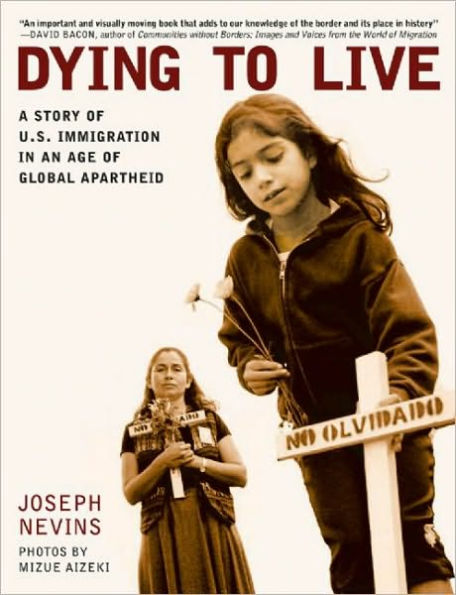
Dying to Live: A Story of U.S. Immigration in an Age of Global Apartheid
225
Dying to Live: A Story of U.S. Immigration in an Age of Global Apartheid
225Paperback
-
PICK UP IN STORECheck Availability at Nearby Stores
Available within 2 business hours
Related collections and offers
Overview
"In Dying to Live, Joseph Nevins and Mizue Aizeki have produced an important and visually moving book that adds to our knowledge of the border and its place in history. Nevins' painstaking research documents the development of the Imperial Valley—its industrial agriculture, its divided cities, and the chasms between rich and poor, Mexican and anglo, that have marred its growth. Through the valley runs the border, and Nevins' accounts of the growth of border enforcement on the U.S. side, and the racism of its legal justifications, will be a strong weapon for human rights activists. Mizue Aizeki takes her camera and tells the story of Julio Cesar Gallegos, who died in the desert trying to make it across. Her images of the stacked bodies of border crossers held in refrigerator trucks, and the barrenness of the ocotillo cactus on the flat hardpan are eloquent testimony to the terrible risks and human costs imposed on migrants. Her beautifully composed portraits of Gallegos' family make a direct appeal to the heart in a way that words cannot. And her documentation of border protests and immigrant rights demonstrations, including the rows of jugs of water put out in the desert to save lives, are all compelling evidence that there is a struggle going on to halt the human rights crisis she and Nevins document."—David Bacon, author of Communities Without Borders: Images and Voices from the World of Migration"Joseph Nevins blows the cover off the scapegoating of 'illegal' immigrants by meticulously and grippingly compiling the history of why so many try to come to the U.S. and, tragically, why so many die. This book strikes at our very moral core."—Deepa Fernandes, author of Targeted, Homeland Security and the Business of Immigration"A fierce and courageous denunciation of the foul politics of immigration and the two-thousand mile tragedy of the Mexican border, snaking its way between two worlds, two nations, separated at birth but forever joined at the hip. Starting from one man's blackened corpse, the tale wends its way across the desert of racial amnesia to reveal the sources of America's reactionary (and futile) attempt at closure of a porous frontier. Deftly stitching together disparate times and places—from the Imperial Valley to Zacatecas to Mexicali and back to East L.A.—Nevins and Aizeki weave a memorial quilt to the hundreds of innocents in unmarked graves."—Richard Walker, professor of geography, UC Berkeley, and author of The Conquest of Bread and The Country in the City."Dying to Live is a compelling, perceptive and invaluable book for our times. Our new apartheid, as explored here, is as bleak and hostile as the landscapes in which people lose their lives trying merely to survive. Those lives delineated here are unforgettable."—Susan Straight, author of A Million Nightingales and Highwire Moon"Invisible in life, like most exploited immigrants, Julio Cesar Gallegos now judges us from the hour of his terrible death. He reminds us–thanks to the passionate investigations of Nevins and Aizeki–that the eyeless corpses in the Imperial Valley are murder victims: abandoned to heat, thirst, and anonymous graves by a border politics compounded of historical ignorance and contempt for human rights."—Mike Davis, author of Planet of Slums and In Praise of Barbarians

Product Details
| ISBN-13: | 9780872864863 |
|---|---|
| Publisher: | City Lights Books |
| Publication date: | 05/01/2008 |
| Series: | City Lights Open Media |
| Pages: | 225 |
| Product dimensions: | 6.10(w) x 7.90(h) x 0.80(d) |
About the Author
Table of Contents
Acknowledgments 9
Author's Note on Language 13
The Bodies 17
The Desert 29
The Border 73
Juchipila, MexUSA 123
Beyond the Boundary 165
Appendices 200
Bibliography 205
Notes 229
Index 245
Biographical Notes 256
What People are Saying About This
"[A] remarkable book."
"Invisible in life, like most exploited immigrants, Julio Cesar Gallegos now judges us from the hour of his terrible death."--(Mike Davis, author "Planet of Slums" and "In Praise of Barbarians")
"...a fierce and courageous denunciation of the foul politics of immigration..."--(Richard Walker, professor of geography, UC Berkeley)
"Joseph Nevins blows the cover off the scapegoating of "illegal" immigrants by meticulously and grippingly compiling the history of why so many try to come to the U.S. and, tragically, why so many die. This book strikes at our very moral core."--(Deepa Fernandes, author of Targeted, Homeland Security and the Business of Immigration)
"An important, visually moving book that adds to our knowledge of the border and its place in history."--(David Bacon, author "Communities Without Borders: Images and Voices from the World of Migration")
Dying to Live is a powerful examination of the messy politics and human consequences of US immigration policies. Joseph Nevins skillfully weaves the personal story of Julio César Gallegos, a migrant who died attempting to cross the US-Mexico boundary, together with detailed historical research to explore the boundary's ideological construction, the USA's 'race-class-nation hierarchy', and the role of law in shaping Americans' geographical imagination. (Nancy Hiemstra, Progress in Human Geography)
"'Dying to Live' is a compelling, perceptive and invaluable book for our times."--(Susan Straight, author of "Highwire Moon")
